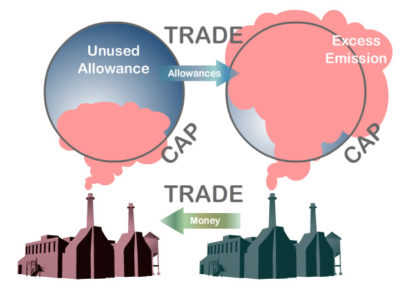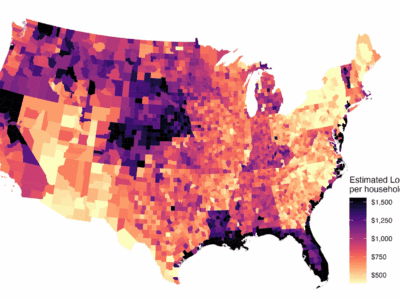Does AB 197 Mean the End of Cap and Trade in California?
Language Directs the Air Resources Board to Prioritize Direct Emissions Reductions
 As Ethan’s post recounts, the California Assembly today passed AB 197, a bill linked to SB 32, which extends California’s climate goals to 2030 and requires emissions reductions by that year of 40 percent below 1990 levels (see my post from yesterday describing the bills and how they are linked). The passage of the two bills is a huge victory for the Governor and will continue the state’s global leadership on climate change. AB 197 does, however, have the potential to alter fairly significantly the path the state has been on to reduce its emissions. My aim in this post is to begin a conversation about what AB 197 is likely to do to the state’s cap-and-trade program. I offer some initial thoughts about the bill’s effects but first explain cap and trade, why the program is controversial and what AB 197 has to say about it.
As Ethan’s post recounts, the California Assembly today passed AB 197, a bill linked to SB 32, which extends California’s climate goals to 2030 and requires emissions reductions by that year of 40 percent below 1990 levels (see my post from yesterday describing the bills and how they are linked). The passage of the two bills is a huge victory for the Governor and will continue the state’s global leadership on climate change. AB 197 does, however, have the potential to alter fairly significantly the path the state has been on to reduce its emissions. My aim in this post is to begin a conversation about what AB 197 is likely to do to the state’s cap-and-trade program. I offer some initial thoughts about the bill’s effects but first explain cap and trade, why the program is controversial and what AB 197 has to say about it.
The centerpiece of California’s efforts to reduce greenhouse gas emissions is, of course, a cap-and-trade program that covers the vast majority of the state’s emissions. Cap-and-trade has many advantages — at least theoretically — over more direct regulation, especially for greenhouse gas emissions that have largely global, not local effects. As I have explained in a previous post from which the following description is taken, under a cap-and-trade scheme, the government sets a total amount of emissions that all of the sources of greenhouse gas emissions covered by the program can emit. That total amount (the cap) is then divided into allowances (usually one allowance equals one ton) and distributed (or auctioned) to the polluters. The polluters can comply with cap and trade in several ways. They can cut their emissions to equal the total amount of allowances they have. They can cut their emissions below the amount of allowances they have and then sell the extra allowances to polluters who need more. They can emit more than they are allowed and buy extra allowances from sources that have extras. Or they can buy a certain percentage of “offsets,” which are pollution reductions from sources not covered by the cap and trade program (see here for a detailed description of offsets). The main idea behind cap and trade is to allow market forces to produce the cheapest emissions reductions instead of having the government decide which reductions will occur. Cap and trade is especially popular for greenhouse gas emissions because the problem is a global one, not a local one. A reduction in carbon dioxide in Ghana is just as good as a reduction in carbon dioxide in California. So cap and trade, if it works effectively, should produce large carbon emissions reductions cost effectively regardless of where the reductions take place.
Environmental justice advocates in California — and a number of supporters in the California legislature — have long been suspicious of cap-and-trade. Indeed advocates sued the California Air Resources Board five years ago to try to invalidate California’s program. The lawsuit was largely unsuccessful. As I explained at the time, the environmental justice opposition to cap-and-trade is based on the following concern. Most of the large emitters of greenhouse gases, especially carbon dioxide, also emit conventional pollution like precursors to ozone pollution (garden variety smog). If those large carbon emitters reduce their own carbon emissions, they are also likely in the process to reduce conventional pollutants: as they use cleaner energy sources or burn less fuel they’ll not only emit less carbon but fewer traditional pollutants. In environmental parlance, reductions in carbon emissions can produce co-benefits in the form of cleaner air. Environmental justice groups in California oppose the idea that cap and trade will allow large polluters to continue polluting while buying their way into compliance under cap and trade. And in California, emitters can “buy” their way to compliance either by purchasing additional allowances or purchasing offset credits from sources like forests that are not covered under the cap.
AB 197 is based on this environmental justice view of cap and trade. Here is it’s most important provision:
38562.5.
When adopting rules and regulations pursuant to this division to achieve emissions reductions beyond the statewide greenhouse gas emissions limit and to protect the state’s most impacted and disadvantaged communities, the state board shall follow the requirements in subdivision (b) of Section 38562 [requirements contained in the original AB 32] , consider the social costs of the emissions of greenhouse gases, and prioritize both of the following:
(a) Emission reduction rules and regulations that result in direct emission reductions at large stationary sources of greenhouse gas emissions sources and direct emission reductions from mobile sources.(b) Emission reduction rules and regulations that result in direct emission reductions from sources other than those specified in subdivision (a).
Reader Comments
10 Replies to “Does AB 197 Mean the End of Cap and Trade in California?”
Comments are closed.







Ann provides a smart survey of the ways that AB 197 may be interpreted and interact with other legal requirements. Another possibility, in the political realm, is expanded *direct* investment of some hundreds of millions or billions of allowance auction revenue in low income communities, polluted communities and in programs promoting industrial shifts suggested in AB 197. This would be a way to address the priorities of AB 197 within the cap and trade structure.
I guess the legal question, Dallas, would be whether using cap and trade money would constitute direct regulation and fit the prioritization language included in AB 197.
Yes, rules about spending the proceeds of cap-and-trade probably don’t count as “Emission reduction rules and regulations.”
Great thoughts, Ann. I too am baffled at how this might play out. From the perspective of someone who works on energy finance (typically renewable, though the same principles would apply to the gas-fired sector), the very vagueness of AB 197 could be enough to make lenders uncomfortable, and raise the cost of capital for those looking to finance the construction and/or ongoing ownership of gas-fired facilities. Given that the cost-comparison between new solar and new natural gas in California is fairly close right now, this could have a material effect.
Hi Ann,
This looks complicated, but maybe the ARB will now (simply?) add on an x% in “priority credit(s)” for direct emissions reductions from large stationary or from mobile sources, and because “other” (small stationary?) sources are listed second in the new priority list, an (x/2)% priority credit for direct emission reductions from other sources.
And maybe credits for non-“priority” GHG reductions, like from carbon capture or sinks (if those even get credit), would decline in value a bit so the whole system balances out? …
Oh, wait. The new language is about “emissions reductions ***beyond*** the statewide greenhouse gas emissions limit,” so maybe it doesn’t implicate cap-and-trade at all. (If cap-and-trade is only about meeting that limit.)
I don’t see what in the Act (as ameded) gives the ARB authority to require reductions beyond the relative-to-1990 emission rate limit (which changes from decade to decade now). Do you?
Hi David – interesting idea about giving extra credit for direct emissions reductions. I think in answer to your question that SB 32 requires the ARB to reduce emissions by 40 percent below the statewide GHG limit, which is the 1990 target. I don’t think cap-and-trade is only about meeting the 1990 limit but is one tool among many that might be used to achieve the 40 percent reductions provided the board gives priority to direct emissions reductions on large stationary sources. Does that make sense?
I’m sorry. I made a mistake. When I thought/wrote “oh, wait” above I was thinking that SB 32 simply reduced the statewide GHG emissions limit by 40%. I just looked back at SB 32 and the law it’s enacting says “. . . the state board shall ensure that statewide greenhouse gas emissions are reduced to at least 40 percent below the statewide greenhouse gas emissions limit no later than December 31, 2030.” So “the statewide greenhouse gas emissions limit” (a term of art now) will remained unchanged. But the legal limit is being reduced. Dang, that’s confusing.
Per HSC 38505(n), ““Statewide greenhouse gas emissions limit” or “statewide emissions limit” means the maximum allowable level of statewide greenhouse gas emissions in 2020, as determined by the state board . . . .” Still 2020, not 2030. Got it?
When is “the limit” not the limit?
When the [legal] limit = “the limit” x (1-40%) = 60% of “the limit” !
In 2030, the legal limit on statewide emissions will be 60% of the “statewide emissions limit.”
So please disregard the last two paragraphs in my comment above.
I hope that cap-and-trade can still be used (even without a 2/3 vote) after 2020. I think a weighting scheme like I described above would satisfy the prioritization requirement of AB 197. Determining proper weights would be interesting and enlightening, because per new HSC Sec. 38562.5, “social costs” would likely have to be quantified and factored in numerically.
I’m baffled. I don’t think this language can be read literally to mean anything, so I will take a stab at what maybe it’s supposed to mean. The underlying intent seems to be to protect disadvantaged communities from non-carbon pollution resulting from trading. Dallas’s suggestion, while appealing (I agree with it as policy), doesn’t actually protect these communities from pollution; instead it compensates them with other benefits. Although I agree with Dalas’s approach, I have a hard time reconciling it with the text. David’s suggestion, to prioritize the three types of emissions mentioned doesn’t seem to fit the format (two emission types in (a) and one in (b).). Besides, it’s not clear why stationary sources should be prioritized over mobile ones, which may be more harmful to poor communities that have older, dirtier cars.
The second problem is the phrase “direct emission reduction.” Does this have to be command-and-control directives to each individual plant? Why wouldn’t a CPP approach that treats the power sector as one big stationary source (if maximum flexibility is utilized) be considered direct emission reductions from stationary sources? Maybe the intent of 197 is to constrain trading so that stationary sources in or near disadvantaged communities cannot avoid reducing their own emissions by buying allowances or limiting the number they can buy. In other words, priority must be given to achieving reductions at those plants.
Picking back up on Dallas’s idea, perhaps 197 would be satisfied if auction proceeds were used to pay for additional reductions at sources in or near disadvantaged communities.
It’s 4:35 a.m. I wonder if Donald Trump is tweeting at this very moment.
I also think prioritizing the use of auction revenue to subsidize rooftop solar and efficiency improvements in disadvantaged communities should be consistent with 197. It would directly reduce emissions from large stationary sources while reducing social costs (energy system costs) in disadvantaged communities.
In short, I don’t see why 197 should act as a bar to flexible, cost-effective regulation, including cap & trade.
I have a question about “pollutants”. We are a small electrical company. About 4 years ago a big trucking agency moved in across the street. They have, of course, trucks. Very large trucks!!! These trucks were always on the move in & out. Pretty soon, they leased all the land next door to our business. These very large trucks filled all the land up. They make big runs, sometimes in & out 24/7. I noticed some years ago a strange “dust” was everywhere. Depending on how hard the wind blows, this dusty “film” like talcum powder really, is “on the move” its dirty, It makes everything dirty. These trucks Leak what they are hauling. And, what they are hauling is recycled Human waste out of Los Angeles, California. They fill the landfill with these loads of recycled human waste. How good do you think we feel after being in business at the same location for 16 years that about 4- of those years now we live, breath, touch these great amounts of recycled human waste. One time this summer when it was very hot and I turned my AC on in my small car this “dust” even came up inside the car through the vents. It struck me as gross!!! I can no longer even keep my car clean. As soon as I have it washed it is coated with this “human waste dust”. We are in Arizona.